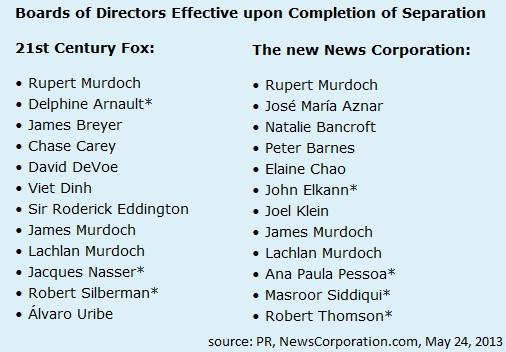Earlier this month, News Corp (NASDAQ:NWSA)‘s investors formally approved the separation of the company’s publishing and entertainment business. A separate corporate entity comprising the publishing unit will be created and the entertainment unit, consisting of film and television operations, will be renamed. The two companies will begin their separate trading from July 1.
The two companies
Last month, News Corp (NASDAQ:NWSA)’s board approved the separation of businesses into two distinct companies, one focusing on the newspaper and book-publication business, including Dow Jones Newswires, New York Post, HarperCollins,The Wall Street Journal and other British and Australian publications. It will be called the New News Corporation. The other will be its entertainment arm, which will be called 21st Century Fox. It includes the 20th Century Fox movie studio, Fox broadcast and cable channels and other entertainment properties.
The board of the two companies will have 12 directors each, including Rupert Murdoch and his sons Lachlan and James, who will sit on the two boards. The company is getting seven new directors – as indicated by a * in the picture below — who weren’t a part of the previous News Corp (NASDAQ:NWSA)’s board. The most prominent new entrant will be Ford Motor Company (NYSE:F)’s former CEO and BHP Billiton Limited (ADR) (NYSE:BHP)‘s chairman Jacques Nasser.

The current shareholders will receive one share of the new News Corp against every four shares of News Corp. News Corp will also implement a $500 million stock repurchase for new News Corp once the separation is complete.
News Corp (NASDAQ:NWSA) has also adopted a one-year “poison pill” provision aimed at preventing further divisions and protecting the interest of shareholders, particularly Rupert Murdoch and his family members. The current shareholders can purchase new shares at a 50% discount if anyone acquires at least a 15% stake in the new News Corp and 21st Century Fox.
This appears to be one of the lessons Mr. Murdoch has learned when, nearly nine years ago, John Malone acquired 16.3% voting shares of the firm and was ultimately able to secure Mr. Murdoch’s stake in DirectTV against his holding.
The company’s publishing arm has struggled, dragging the income of News Corp (NASDAQ:NWSA). Last year, News Corp booked $2.8 billion in impairment charges, mainly due to its publication unit. In the current quarter, News Corp’s income will take a hit of between $1.2 billion and $1.4 billion as pre-tax charges related to write downs of the publishing unit’s assets.
Meanwhile, its shares have risen by 23.8% in the last six months in anticipation of the split. By comparison, the S&P 500 ETF (SPY) has trailed far behind, showing a rise of 14% in the corresponding period.
In its last quarterly results, News Corp managed to beat both top- and bottom-line estimates. Its quarterly income increased threefold to $2.8 billion, or $1.22 per share. Earnings received the boost due to one-time gains and strong performance of cable networks. Adjusted earnings were $0.36 per share, beating the market’s estimates by $0.01. Revenue rose by 13.5% to $9.5 billion from $8.4 billion in the same quarter last year.
However, operating income of the publishing business fell by 34.6% while revenue dropped by 4.3% on the back of falling ad revenue, particularly of the Australian newspapers.
| Segments | 2012(In Millions) | 2013(In Millions) | % Change |
|---|---|---|---|
| Cable Network Programming | $846 | $993 | 17.4% |
| Filmed Entertainment | $272 | $289 | 6.3% |
| Television | $171 | $196 | 14.6% |
| Direct Broadcast Satellite TV | $40 | -$11 | -127.5% |
| Publishing | $130 | $85 | -34.6% |
The new News Corp will have a market cap of $10 billion–that is almost equal to the quarterly revenue of the current News Corp.
The new News Corp (NASDAQ:NWSA) will start fresh with approximately $2.6 billion cash and zero debt. The company believes that with the resources at its disposal, it is in a better position than its peers, such as Gannett Co., Inc. (NYSE:GCI) and The New York Times Company (NYSE:NYT), to expand its business through strategic acquisitions.
Last week, Gannett announced the acquisition of Belo Corp. (NYSE:BLC) in a massive $1.5 billion deal. Through this, Gannett Co., Inc. (NYSE:GCI)will double its broadcast network of stations. The company is moving into higher margin operations and despite the debt-financed acquisition, it is sticking with its $300 million buyback program, which I believe shows the management’s confidence in the company’s cash position.
The New York Times Company (NYSE:NYT) has been struggling with declining print and advertising revenue. To offset the negatives coming from the changing market dynamics, the New York Times has adopted a digital model. I believe that so far, the management has been able to effectively implement the new strategy aimed at increasing its foothold in the digital world, which was shown in its recent numbers.
The company has recently reported an 18% rise in total circulation and an impressive 41% increase in digital circulation, although home-delivery circulation remained weak showing an increase of just 0.5% for the six months ending March 2013. However, a recent article at Politico has highlighted an internal crisis centered around executive editor Jill Abramson. The company is franchising the New York Times brand and moving forward in the online world, but I am not sure if its future includes Abramson.
News Corp (NASDAQ:NWSA)’s executives insist that by separating the two units, they will be able to properly focus on the publishing business and will be able to turn it around. This it plans to do by increasing subscription costs, launching a new service that offers the latest content first to the premium customers, and by investing in mobile growth.
My Foolish take
On the other hand, the advertising revenue in general has moved toward electronic media, which is why I am not optimistic about the future of the print-media focused publishing and newspaper firms.
News Corp (NASDAQ:NWSA)’s current publishing operation is running on an obsolete business model in which most of its content is basically a rehash of other articles from the leading news agencies, such as Reuters, and gives little value to the readers.The phone hacking scandal has also tarnished its reputation.
Moreover, the company’s track record with new publication ventures, particularly in the online world, is far from glittering. This was evident in the failure of its tablet focused publication called “The Daily” – which charged its users for information which was already available all over the Internet for free.
However, the positive in the division of the business is that the publishing arm will no longer drag down the earnings of News Corporation, and I believe this makes the entertainment-focused 21st Century Fox a much better firm.
Sarfaraz Khan has no position in any stocks mentioned. The Motley Fool has no position in any of the stocks mentioned. Sarfaraz is a member of The Motley Fool Blog Network — entries represent the personal opinion of the blogger and are not formally edited.
The article News Corp Split: A Brighter Future for Publishing? originally appeared on Fool.com and is written by Sarfaraz Khan.
Copyright © 1995 – 2013 The Motley Fool, LLC. All rights reserved. The Motley Fool has a disclosure policy.




